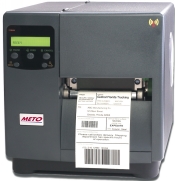Targeting companies still uncertain about the timing of their RFID deployment plans, retail security systems and label provider Checkpoint Systems has launched its first label printer supporting RFID. The new printer comes in two versions. The fully enabled version features both RFID reading/writing and thermal bar code printing capabilities; the upgradeable version lacks RFID reading/writing capabilities, but customers can add an RFID reader at a later date as their RFID plans are finalized.
“A lot of customers have been holding off investing in thermal bar code printers because they may need RFID capabilities further on,” says Theo Bielowicz, bar code systems product manager at Checkpoint Systems, which is based in Thorofare, N.J.
Checkpoint’s Meto mi-4210 RFID printer can encode a smart label’s RFID tag and also print the label with a product-specific bar code and human-readable text. The company joins a growing list of companies—including Paxar, Printronix and Zebra Technologies—that make thermal desktop printers for smart labels.
Checkpoint entered the bar code label-printing business in 1999 when it acquired the German company Meto. The company says it decided to introduce a smart-label printer/encoder now because retail giants Wal-Mart, Target and Albertsons and the U.S. Department of Defense are all requiring their suppliers to begin put RFID tags on shipments in 2005, thus providing Checkpoint with an attractive market opportunity to serve those suppliers.
“We have had some interest from the top 100 Wal-Mart vendors but also from tier 2 and tier 3 suppliers and from retailers that aren’t part of any mandate yet,” says Bielowicz. “RFID, bar code and human-readable will be complementary technologies for a long time.”
According to Checkpoint, an RFID reader installed in the mi-4210 printer can read and write to an incoming label before the thermal printing of bar code and human-readable data on the label. Having an RFID reader on the printer ensures that the label is working correctly before and after printing. This process has the reader identifying the next smart label to encode and testing that it works correctly. If the label passes the RFID test, it would then be printed with a thermal image and read again to ensure that its embedded RFID tag was encoded correctly. If the label’s RFID tag cannot be read, either before or after printing, the label is printed with the word “void” or a series of X’s to make it obvious that its RFID tag is defective.
Checkpoint will also offer versions of its mi-4210 RFID printer to support a range of RFID frequencies. The first version available supports RFID tags operating at 13.56 MHz (HF). A version supporting Alien Technology’s EPC-compliant 915 MHz (UHF) tags is currently beta and set for release later in June, while a third version supporting Matrics’s EPC Class 0 tags is expected to be ready within a few months.
The printer, which measures 13 inches long by 12.5 inches wide and 18.5 inches deep, has a printing speed of 10 inches per second. A variety of connections including Ethernet, serial, parallel, coaxial cable and Wi-Fi can all be used to connect the unit to an enterprise network.
The RFID-upgradeable version of the printer is priced at $2,200, with the 13.56 MHz RFID-capable version set for sale at $2,999. Pricing for the UHF version has yet to be determined.
Attend RFID Journal
University
There is less than three weeks left until RFID Journal University in Atlanta. This unbiased educational course, presented by RFID Journal and members of Auto-ID Labs, is designed to provide the in-depth understanding of RFID and EPC technologies needed to evaluate vendors and begin planning a successful implementation. Register today, or to see complete course outlines, visit RFID U.


